
The Story of Horseshoe Lake at Woodhaven
By Leonard Oliver Nasman, copyright 1998
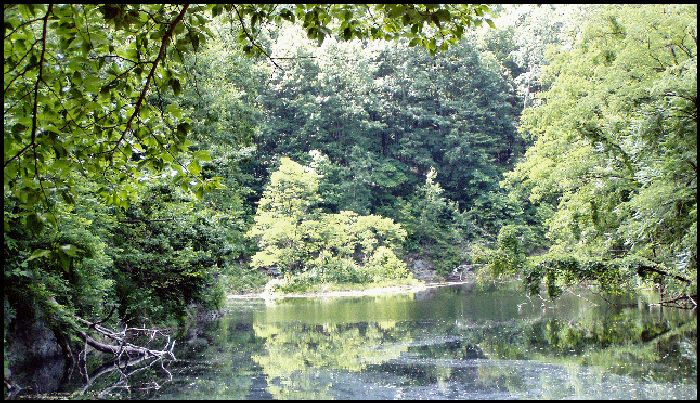
Horseshoe Lake
Horseshoe Lake (at our country retreat called Woodhaven) is a long narrow curving lake with a surface area of about four acres. One side of the lake is dominated by a nearly 100 foot high sandstone cliff, while the other side consists of a steep dirt hill covered with a large variety of trees. On one of the inside curves of the lake is a large beaver lodge. Several small intermittent streams feed the lake with a combination of spring water and rain water and maintain a fairly constant lake elevation. In the 1990’s, Horseshoe Lake might appear to the casual observer to be naturally formed. However, it is actually the result of coal mining activity of the 1940’s and 1950’s.
The Creation of Horseshoe Lake
In the 1940’s coal was a major source of energy. It was used to heat private houses and public buildings. It fueled the steam locomotives that pulled trains that were the major method of transportation. Coal was also used to generate electric power. In those days, Ohio was a major source of coal, and some of it came from right here at Woodhaven. Although there were a few areas of Ohio where coal was obtained from underground mines, most Ohio coal came from strip mines.
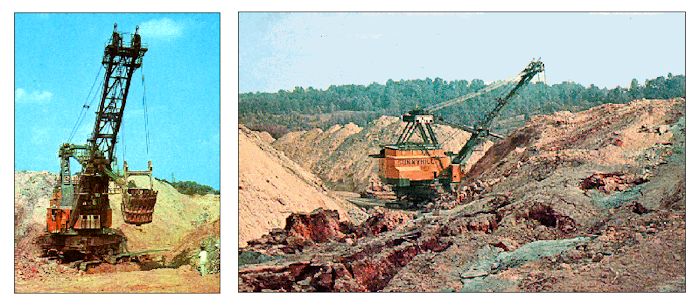
Strip mines are created by first removing the overburden to get at the coal seam. The overburden is the soil and rock that is on top of the coal. In the Woodhaven area the overburden is about 100 feet deep. Part of the overburden is top soil, then comes a layer of sandstone, then shale (thin layers of soft rock), then the coal seam. The coal seam in this area is about 18 inches thick. This is much too thin for underground mining. After the overburden is removed, the coal is scraped up and hauled away. The overburden is removed with giant shovels like the one shown here.
The man standing in the lower right corner of the first picture provides an idea of how big these shovels were. If you look really hard you can see the shovel operator. He is the light spot in the orange section on the left side of the shovel house. The first of these types of machines were powered by steam engines and many still refer to them as steam shovels. Most folks do not realize that big steam shovels were around quite a while before automobiles became common.

Actually, a little to the east of here, near Zanesville, Big Muskie was used. As high as a 22 story building, and in its day it was the biggest earth moving machine ever built. The total weight of bucket was around 469,000 lbs. (230 tons) and the machine weighed in at 27,000,000 lbs (13,500 tons). Big Muskie was operated at Central Ohio Coal Company's Muskingum mine near Zanesville, Ohio.
It operated until January 1991 and was parked until it was finally sold for scrap. The shovel from Big Muskie was preserved in a small park located near a wildlife preserve called The Wilds. It could scoop 220 cubic yards of earth at a time. That is a pile of dirt about half of the volume of the two story part of the Woodhaven house. But, I digress.
In the Woodhaven area, the strip mining technique was to excavate an area by following the hills slightly below the 1,000 foot elevation contour line. This is roughly the elevation of the coal seam in the area.
After moving a wide area of dirt to expose a layer of coal, the sandstone rock in the overburden was blasted and the shovel was used to move another section of the hill to the area just excavated. Then, an auger (a big screw) was sometimes used to dig out some more coal without having to move more overburden.
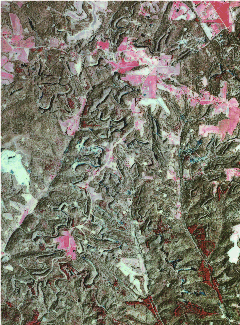
Then the big shovel was moved on, leaving a 100 foot or so wide valley. On the side of the excavation where the sandstone rock was exposed, a cliff was created. This is known locally as the ‘high wall’. In those days, there was no requirement that the landscape be restored. So, this area was left pretty much as you see in the above picture.
The infrared aerial photo shows the area around Woodhaven. You can follow the path of the big shovel as it dug its way around. This picture was taken in April of 1988, The light pink areas of the photo are farm fields with new green vegetation showing as pink. The dark red areas are green pine trees. The light blue areas are shallow water and the very dark blue areas are deeper water. (In infrared, the cooler the object, the darker the color.) If you look closely you might be able to make out roads (light colored lines) that run through the area.
In 1975, a law was passed requiring that all new strip mines be put back close to their original condition. However, in the area around Woodhaven the mines were all created long before this requirement was in place. All reclamation work here has been conducted by Mother Nature and her little helpers.
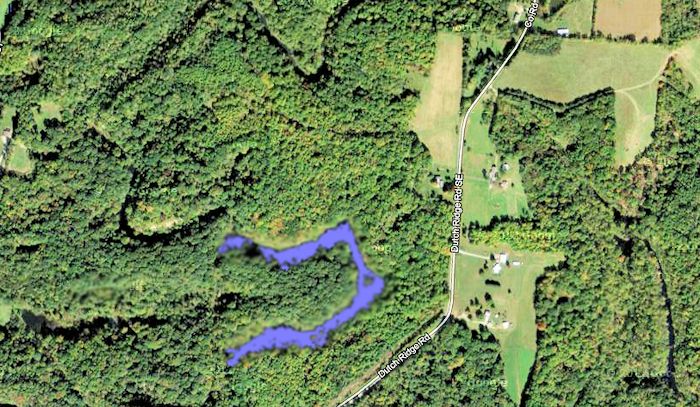
The wind plays a big part in Mother Nature’s reclamation program. The wind blows seeds to the piles of dirt left by the miners. Before long, grass and wild flowers start to cover the ground. Then comes the trees. Some trees, like the locust, do well in the poor soil. Each fall the leaves cover the earth and add nutrients to the soil. More trees follow.
Some of Mother Nature’s helpers have been the birds. They help spread seeds from many different varieties of trees and shrubs. Fast growing trees like the aspens happen also to be a favorite of the beavers.
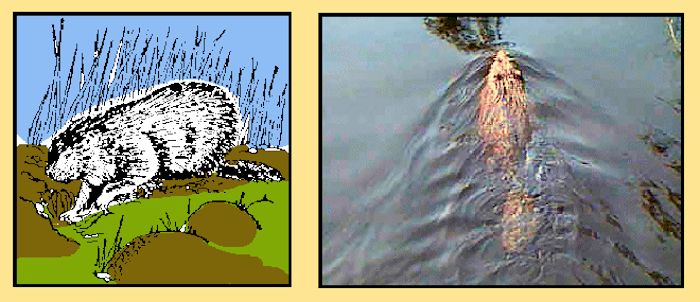
In the case of Woodhaven, beavers have been major helpers in the natural reclamation project. They have built two dams at Horseshoe Lake, one at each end of the ‘horseshoe’. This has created the lake. It is 15 to 20 feet deep in some places. If you travel by boat from one dam to the other you will travel about a half mile.

The beavers have also built other dams and created a whole series of canals, ponds, and lakes in the area. Why do they do this? They build a lake so that they will have a safe place for their lodge. The lodge is a pile of mud and sticks, and is always built so that the entrances are underwater tunnels. This keeps their pups safe from foxes or other pup stealing critters.
Beavers do not hibernate during the winter like their cousins the woodchucks. So, they need a food supply that they can eat even when the lake is frozen solid with ice. They eat tree bark during the winter. Their favorite is nice juicy aspen bark. If the aspen supply gets low, they will eat other tree bark. In the fall, they start collecting the winter food supply by cutting tree branches, dragging and floating them near the lodge, and sticking the ends of the branches in the mud at the bottom of the lake.

Beavers are very good lumberjacks, and they can cut down large trees. At times they will eat all of the bark from the larger logs where they fall, and drag the smaller branches to their lodge. Since some of the trees they cut might be quite a distance from the lodge, they create a series of canals and ponds to make it easier to move the branches.
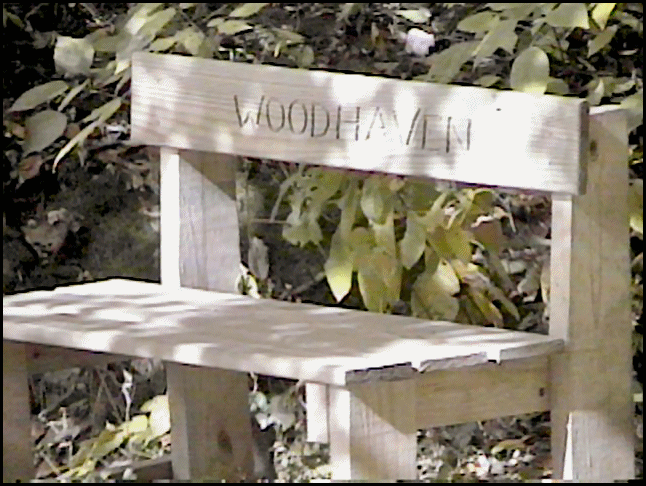
The result of over 40 years of natural reclamation is the beautiful Horseshoe Lake and its surroundings. With the addition of some human labor in creating a path to the water’s edge, and the addition of a nice bench to sit on, you can now enjoy Mother Nature’s handiwork.

Web page copyright © 2005 by Leonard Oliver Nasman. All rights reserved.
